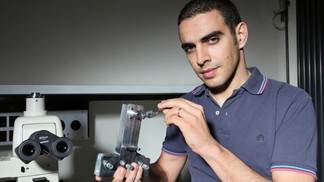April 2, 2012
 |
| Ricardo Beira ©2012 Alain Herzog |
More precision and less cost for endoscopic surgeries: the tool developed by DistalMotion, a spin-off of EPFL, will allow surgeons to reproduce their exact movements. The prototype was just released from the lab, and on the 29th of March, the start-up received 130,000 Swiss francs in the final phase of the Venture Kick prize.
A machine that allows highly skilled surgeons to effectively lengthen their fingers has been designed in the Robotics System Laboratory. Ricardo Beira elaborated this idea in his thesis, and subsequently created the start-up, DistalMotion, to further develop it:. The device is controlled by small joysticks which allow the operation of surgical tools fixed to the end of a metal arm. The goal? To facilitate minimally invasive operations without opening the abdominal wall.
Two to three bodily orifices allow for the passage of a small camera and long surgical instruments. This technique, known as endoscopy, is used more and more in urology, gynecology and visceral surgery.While this technique has many benefits, the main problem is the lack of precision in the surgeon’s movements, which is linked to the rigidity of the tools. Moreover, the surgeon must work with a mirror as, for example, a movement to the surgeon’s left results in the tool moving to the right; hence, a particularly intense training is necessary. Ricardo Beira’s system solves these problems.
Completely Mechanical
The small joysticks are able to exactly replicate the surgeon’s movements,. As a result, pliers, scissors, needles and other tools move as if a practitioner was directly holding them. The research completed at the robotics laboratory has allowed for the elimination of a problem inherent to such mechanisms, the exaggeration of movements. When a small movement outside of the patient’s body is translated into a larger one inside the patient, operations become even more. delicate and painstaking. Thanks to this device, seven degrees of freedom are permitted in the reproduction of movement, including, for example, the rotation of the wrist.
In the era of robotics crammed with electronics, detectors and sensors, this mechanical engine developed by Ricardo Beira is quite remarkable. It should permit a considerable expansion of the variety of coelioscopic procedures, which present numerous advantages in relation to traditional surgery, notably with regard to safety, aesthetics and cost. The post-operative pain and risk of infection are lesser, the scars are smaller, and the stay at the hospital shorter.
The device requires craftsmanship of the highest and most detailed order, but the horizon is bright due to the numerous foreseen advantages . “The future cost of production will lie outside a common measure with the only devices capable of this much mobility in this type of operation, the DaVinci robots. These enormous devices, which equip only a few hospitals in the world, cost millions and necessitate huge spaces,”explains Ricardo Beira.
Second Prototype and Pre-Clinical Trials
Pre-clinical trials at the CHUV and the Inselspital in Bern will take place this year with simulations of prostate operations. The product was redesigned to give it a more appealing form for the market. The start-up has just been created, but a few days ago it won the final phase of Venture Kick, an aid to young talents worth up to 130,000 Swiss francs. The validation process of the system is in progress.
Source: EPFL
Related Information:
0 comments:
Post a Comment